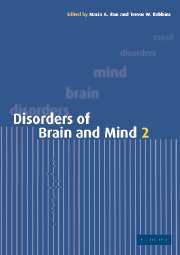Book contents
- Frontmatter
- Contents
- List of contributors
- Preface
- Part I Genes and behaviour
- Part II Brain development
- Part III New ways of imaging the brain
- Part VI Imaging the normal and abnormal mind
- Part V Consciousness and will
- Part IV Recent advances in dementia
- Part VII Affective illness
- 14 The neuropathology of mood disorders
- 15 The neural substrates of anxiety
- 16 Social separation models of depression
- Part VIII Aggression
- Part IX Drug use and abuse
- Index
- Plate section
- References
15 - The neural substrates of anxiety
from Part VII - Affective illness
Published online by Cambridge University Press: 19 January 2010
- Frontmatter
- Contents
- List of contributors
- Preface
- Part I Genes and behaviour
- Part II Brain development
- Part III New ways of imaging the brain
- Part VI Imaging the normal and abnormal mind
- Part V Consciousness and will
- Part IV Recent advances in dementia
- Part VII Affective illness
- 14 The neuropathology of mood disorders
- 15 The neural substrates of anxiety
- 16 Social separation models of depression
- Part VIII Aggression
- Part IX Drug use and abuse
- Index
- Plate section
- References
Summary
Introduction
The aim of this chapter is to try to bring together some of the recent advances in the study of the neural substrates of fear and anxiety in laboratory animals to form a coherent overview that will facilitate comparisons between these basic studies and clinical investigations. The advances made in the study of animal models of anxiety over the past decade are little short of remarkable, especially in the field of conditioned fear. We may now with some confidence map out likely neural mechanisms from the level of functional systems to the cellular and molecular details. We know much of which neuroanatomical areas, neural projections, neurotransmitter systems and receptors are involved in the acquisition and expression of a number of fear-related behaviours.
This is fine progress indeed, but often begs the question of direct relevance to clinical applications. To what extent is the study of conditioned fear and anxiety in animals easily translated into the neuropsychiatric domain? There are several approaches to answering this question. One might suggest that clinical anxiety does indeed reflect a specific neuropathology in a specific behavioural system that is well described at the neurobiological and behavioural level (e.g. patterns of defensive behaviour; Rodgers 1997). This approach values certain forms of animal model over others (e.g. ethological vs. conditioning-based models), and to a certain degree adheres to the suggestion that anxiety reflects a pathological state of a perfectly normal fear system.
Information
- Type
- Chapter
- Information
- Disorders of Brain and Mind , pp. 308 - 337Publisher: Cambridge University PressPrint publication year: 2003
References
Accessibility standard: Unknown
Why this information is here
This section outlines the accessibility features of this content - including support for screen readers, full keyboard navigation and high-contrast display options. This may not be relevant for you.Accessibility Information
- 3
- Cited by
